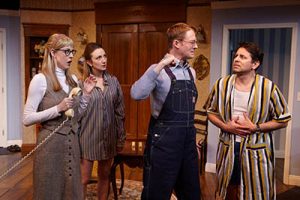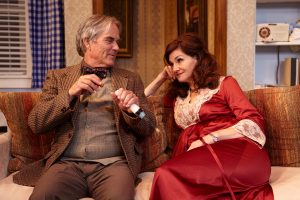The A’s, E’s and I’s Have It in NCR’s OK ‘Other Half’
“I don’t think that I’ve ever been a political writer,” Britain’s Sir Alan Ayckbourn once told London’s The Guardian newspaper, “but I think I’ve been a social writer. I am interested in the world around me, although I generally write about the domestic, so it’s more the Jane Austen model of managing to reflect her times without having too much on the Napoleonic wars.”
The author of 80 plays (versus Billy-Bob Shakespeare’s 37) has occasionally taken a hit for that approach. His critics say that British theater lives and dies by its political bent (they’re absolutely right), and they assert he’d do well to fuel his jaunty humor with a couple treatises on the monarchy’s future or Prince William’s idea of British influence on the Africa he loves.

William Featherstone (Benjamin Cole, foreground) faces off with Bob Phillips (Christopher M. Williams, right) as Mary Featherstone (Noelle Marion, left) and Teresa Phillips (Sharon Rietkerk) feign something like indignation. Photos by Aaron Rumley.
You won’t find any affairs of state in Ayckbourn’s How the Other Half Loves, the OK (if lightweight) mount at North Coast Repertory Theatre — but as you’ll see, “affairs” is a relative term. So is unadorned conceit, which most of these characters display in abundance; the subtext they embrace is as clear as it is funny. There’s nothing here that beats the world, but the package will see the cast — and you — safely through the run.
The end of the ‘60s is upon three suburban London couples, which include middling Bob and Teresa Phillips — while he worships the grass he walks on, she spends her days watching it grow in between her fruitless efforts at letter publication in the selfsame Guardian. The other half consists of Bob’s well-heeled boss Frank Foster and his trophy wife Fiona, whom scruffy Bob has it for. Their trysts eventually compound as both couples befriend company accountant William Featherstone and trepid wife Mary.
From there, the actors intersect ad infinitum amid dinner parties held on successive evenings (and staged at the same time). The befuddled Featherstones, unwitting alibis amid Bob and Fiona’s affair, are thus stuck between the Phillipses’ threadbare home and the Fosters’ upscale quarters — and they find that any reference to “the other half” is immaterial amid the evenings’ reality.
Misunderstandings, half-truths and downright falsehoods pepper the conversation on both sides, magnified through the divisiveness that comes with class and marriage (when Theresa announces she’s left Bob, Frank innocently asks, “Where?”). If the Phillipses and Fosters aren’t armchair politicians, then no one is.
Think ‘Who’s Afraid of Virginia Woolf’ lite . . .
Reportedly, Ayckbourn originally suggested that the dinner parties scene be mounted on the same set — in its day, the idea was regarded as a minor stroke of genius, and it certainly works here. Where else could such skullduggery take place to such effect than on its exact spot, and over such a pleasant interlude as the evening meal?
And note something else: Ayckbourn’s speeches are overwhelmingly vowel-specific, inviting overpronunciation as a character tool; the cast has responded accordingly as their vocalisms exude the parity of it all. Director Geoffrey Sherman may or may not have intended this effect — if the former, he deserves a special nod for his attention to the a’s and e’s and i’s.
Fiona (Jacquelyn Ritz) cares as little for stupid husband Frank (James Newcomb) as she does for delusional Bob (Christopher M. Williams) — Ritz plays the detachment well even as Newcomb’s and Williams’ characters are terminally stuck on themselves for different reasons.
Sharon Rietkerk’s Teresa has an excellent sense of propriety — she’s demonstrably miserable in her marriage, but Rietkerk nicely turns her private rage into public irony.

Frank Foster (James Newcomb) is the canary, while wife Fiona (Jacquelyn Ritz) can barely contain her boredom as the cat.
Marty Burnett’s set is appointed accordingly, with the dowdy Phillips house abutting the high-end Foster layout — but remember, Ayckbourn’s the one who forwarded the design idea. The rest of the tech is pretty good, although Eliza Benzoni’s costumes mildly overreflect the characters amid their use of solid hues.
Are these characters particularly interesting in and of themselves? In fairness, not really, and certainly not as a group — but that’s one of the things that make Other Half watchable. Each figure, after all, has hopelessly assumed the others’ marital despond just as the 1970s are set to visit their self-indulgence on the group. It’s not hard to imagine what the future holds for these people, but Ayckbourn’s kid-gloves approach yields a user-friendly approach to that end.
If life hands you a lemon . . .
This review is based on the matinee performance of April 15. How the Other Half Loves runs through May 13 at North Coast Repertory Theatre, 987-D Lomas Santa Fe Drive in Solana Beach. $46-$53. northcoastrep.org, (858) 481-1055.

Martin Jones Westlin, principal at editorial consultancy Words Are Not Enough and La Jolla Village News editor emeritus, has been a theater critic and editor/writer for 25 of his 47 years…
More…
